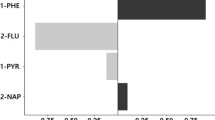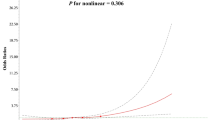Abstract
Links between environmental chemicals and human health have emerged over the last few decades, but the effects from polyaromatic hydrocarbons were less studied, compared to other commonly known environmental chemicals such as heavy metals, phthalates, arsenic, phenols and pesticides. Therefore, it was aimed to study the relationships of urinary polyaromatic hydrocarbons and adult cardiovascular disease and cancer using human sample in a national and population-based study in recent years. Data was retrieved from US National Health and Nutrition Examination Surveys, 2011–2012, including demographics, self-reported health conditions and urinary polyaromatic hydrocarbons. Statistical analyses included chi-square test, t test, survey-weighted logistic regression modeling and population attributable risk (PAR) estimation. Of 5560 American adults aged 20–80 and included in the statistical analysis, urinary polyaromatic hydrocarbons (representatively in one-third sample) were observed to be higher in people with cardiovascular disease and total cancer. In particular, urinary 4-hydroxyphenanthrene was associated with hypertension (odds ratio (OR) 1.33, 95 % confidence interval (CI) 1.00–1.76, P = 0.048, PAR 5.1 %), urinary 1-hydroxypyrene was significantly associated with heart attack (OR 1.47, 95 %CI 1.05–2.06, P = 0.027, PAR 1.7 %), and urinary 2-hydroxynapthalene (2-naphthol) was associated with cancer (OR 1.46, 95 %CI 1.12–1.90, P = 0.008, PAR 3.9 %). Urinary polyaromatic hydrocarbons were associated with adult hypertension, heart attack and cancer, although the causality cannot be established. From the research perspective, future studies with a longitudinal or experimental approach would be suggested. From the law and public health perspectives, regulation on minimizing exposure to polyaromatic hydrocarbons might need to be considered in future health and environmental policies and intervention programs.
Similar content being viewed by others
References
Ball A, Truskewycz A (2013) Polyaromatic hydrocarbon exposure: an ecological impact ambiguity. Environ Sci Pollut Res Int 20:4311–4326
Centers for Disease Control and Prevention (CDC). National Center for Health Statistics (NCHS). National Health and Nutrition Examination Survey Data. Hyattsville, MD: U.S. Department of Health and Human Services, Centers for Disease Control and Prevention (2012) [http://www.cdc.gov/nchs/nhanes.htm]
Eom SY, Yim DH, Moon SI, Youn JW, Kwon HJ, Oh HC, Yang JJ, Park SK, Yoo KY, Kim HS, Lee KS, Chang SH, Kim YD, Kang JW, Kim H (2013) Polycyclic aromatic hydrocarbon-induced oxidative stress, antioxidant capacity, and the risk of lung cancer: a pilot nested case-control study. Anticancer Res 33:3089–3097
Fleiss JL (1979) Inference about population attributable risk from cross-sectional studies. Am J Epidemiol 110:103–104
Freitas F, Brucker N, Durgante J, Bubols G, Bulcão R, Moro A, Charão M, Baierle M, Nascimento S, Gauer B, Sauer E, Zimmer M, Thiesen F, Castro I, Saldiva P, Garcia SC (2014) Urinary 1-hydroxypyrene is associated with oxidative stress and inflammatory biomarkers in acute myocardial infarction. Int J Environ Res Public Health 11:9024–9037
Gentner NJ, Weber LP (2011) Intranasal benzo[a]pyrene alters circadian blood pressure patterns and causes lung inflammation in rats. Arch Toxicol 85:337–346
Kraus U, Breitner S, Schnelle-Kreis J, Cyrys J, Lanki T, Rückerl R, Schneider A, Brüske I, Gu J, Devlin R, Wichmann HE, Zimmermann R, Peters A (2011) Particle-associated organic compounds and symptoms in myocardial infarction survivors. Inhal Toxicol 23:431–447
Luebke RW, Hodson PV, Faisal M, Ross PS, Grasman KA, Zelikoff J (1997) Aquatic pollution-induced immunotoxicity in wildlife species. Fundam Appl Toxicol, 37:1–15
Lee KH, Shu XO, Gao YT, Ji BT, Yang G, Blair A, Rothman N, Zheng W, Chow WH, Kang D (2010) Breast cancer and urinary biomarkers of polycyclic aromatic hydrocarbon and oxidative stress in the Shanghai Women’s Health Study. Cancer Epidemiol Biomarkers Prev 19:877–883
Mendis S, Sobotka PA, Euler DE (1995) Expired hydrocarbons in patients with acute myocardial infarction. Free Radic Res 23:117–122
O'Toole TE, Conklin DJ, Bhatnagar A (2008) Environmental risk factors for heart disease. Rev Environ Health 23:167–202
Shiue I (2013a) Urine phthalate concentrations are higher in people with stroke: United States national health and nutrition examination surveys (NHANES), 2001-2004. Eur J Neurol 20:728–731
Shiue I (2013b) Association of urinary arsenic, heavy metal, and phthalate concentrations with food allergy in adults: national health and nutrition examination survey, 2005-2006. Ann Allergy Asthma Immunol 111:421–423
Shiue I (2013c) Urinary environmental chemical concentrations and vitamin D are associated with vision, hearing, and balance disorders in the elderly. Environ Int 53:41–46
Shiue I (2014a) Arsenic, heavy metals, phthalates, pesticides, hydrocarbons and polyfluorinated compounds but not parabens or phenols are associated with adult remembering condition: US NHANES, 2011-2012. Environ Sci Pollut Res Int 22:6381–6386
Shiue I (2014b) Higher urinary heavy metal, phthalate, and arsenic but not parabens concentrations in people with high blood pressure, U.S. NHANES, 2011-2012. Int J Environ Res Public Health 11:5989–5899
Shiue I (2015a) Urinary heavy metals, phthalates, phenols, thiocyanate, parabens, pesticides, polyaromatic hydrocarbons but not arsenic or polyfluorinated compounds are associated with adult oral health: USA NHANES, 2011-2012. Environ Sci Pollut Res Int. doi:10.1007/s11356-015-4561-0
Shiue I (2015b) Urinary parabens and polyaromatic hydrocarbons independent of health conditions are associated with adult emotional support needs: USA NHANES, 2005-2008. Environ Sci Pollut Res Int. doi:10.1007/s11356-015-4749-3
Trochimowicz HJ, Reinhardt CF, Mullin LS, Azar A, Karrh BW (1976) The effect of myocardial infarction on the cardiac sensitization potential of certain halocarbons. J Occup Med 18:26–30
Conflict of interest
The author declares that she has no competing interests.
Author information
Authors and Affiliations
Corresponding author
Additional information
Responsible editor: Philippe Garrigues
Rights and permissions
About this article
Cite this article
Shiue, I. Are urinary polyaromatic hydrocarbons associated with adult hypertension, heart attack, and cancer? USA NHANES, 2011–2012. Environ Sci Pollut Res 22, 16962–16968 (2015). https://doi.org/10.1007/s11356-015-4922-8
Received:
Accepted:
Published:
Issue Date:
DOI: https://doi.org/10.1007/s11356-015-4922-8




